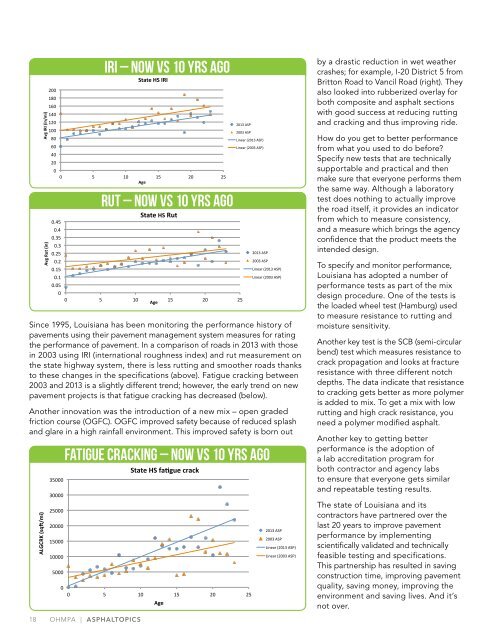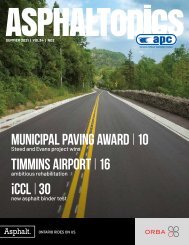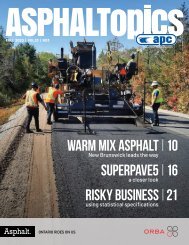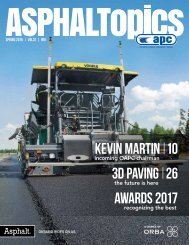ASPHALTopics | Fall 2015 | VOL 28 | NO 3
You also want an ePaper? Increase the reach of your titles
YUMPU automatically turns print PDFs into web optimized ePapers that Google loves.
200 <br />
180 <br />
160 <br />
140 <br />
120 <br />
100 <br />
80 <br />
60 <br />
40 <br />
20 <br />
0 <br />
0 5 10 15 20 25 <br />
Age <br />
Since 1995, Louisiana has been monitoring the performance history of<br />
pavements using their pavement management system measures for rating<br />
the performance of pavement. In a comparison of roads in 2013 with those<br />
in 2003 using IRI (international roughness index) and rut measurement on<br />
the state highway system, there is less rutting and smoother roads thanks<br />
to these changes in the specifications (above). Fatigue cracking between<br />
2003 and 2013 is a slightly different trend; however, the early trend on new<br />
pavement projects is that fatigue cracking has decreased (below).<br />
Another innovation was the introduction of a new mix – open graded<br />
friction course (OGFC). OGFC improved safety because of reduced splash<br />
and glare in a high rainfall environment. This improved safety is born out<br />
ALGCRK (sq9/mi) <br />
Avg IRI (in/mi) <br />
Avg Rut (in) <br />
0.45 <br />
0.4 <br />
0.35 <br />
0.3 <br />
0.25 <br />
0.2 <br />
0.15 <br />
0.1 <br />
0.05 <br />
18 OHMPA | ASPHALTOPICS<br />
IRI – now vs 10 yrs ago<br />
State HS IRI <br />
0 <br />
0 5 10 15 20 25 <br />
Age <br />
35000 <br />
30000 <br />
25000 <br />
20000 <br />
15000 <br />
10000 <br />
5000 <br />
rut – now vs 10 yrs ago<br />
State HS Rut <br />
2013 ASP <br />
2003 ASP <br />
Linear (2013 ASP) <br />
Linear (2003 ASP) <br />
0 <br />
0 5 10 15 20 25 <br />
Age <br />
2013 ASP <br />
2003 ASP <br />
Linear (2013 ASP) <br />
Linear (2003 ASP) <br />
Fatigue Cracking – now vs 10 yrs ago<br />
State HS fa;gue crack <br />
2013 ASP <br />
2003 ASP <br />
Linear (2013 ASP) <br />
Linear (2003 ASP) <br />
by a drastic reduction in wet weather<br />
crashes; for example, I-20 District 5 from<br />
Britton Road to Vancil Road (right). They<br />
also looked into rubberized overlay for<br />
both composite and asphalt sections<br />
with good success at reducing rutting<br />
and cracking and thus improving ride.<br />
How do you get to better performance<br />
from what you used to do before?<br />
Specify new tests that are technically<br />
supportable and practical and then<br />
make sure that everyone performs them<br />
the same way. Although a laboratory<br />
test does nothing to actually improve<br />
the road itself, it provides an indicator<br />
from which to measure consistency,<br />
and a measure which brings the agency<br />
confidence that the product meets the<br />
intended design.<br />
To specify and monitor performance,<br />
Louisiana has adopted a number of<br />
performance tests as part of the mix<br />
design procedure. One of the tests is<br />
the loaded wheel test (Hamburg) used<br />
to measure resistance to rutting and<br />
moisture sensitivity.<br />
Another key test is the SCB (semi-circular<br />
bend) test which measures resistance to<br />
crack propagation and looks at fracture<br />
resistance with three different notch<br />
depths. The data indicate that resistance<br />
to cracking gets better as more polymer<br />
is added to mix. To get a mix with low<br />
rutting and high crack resistance, you<br />
need a polymer modified asphalt.<br />
Another key to getting better<br />
performance is the adoption of<br />
a lab accreditation program for<br />
both contractor and agency labs<br />
to ensure that everyone gets similar<br />
and repeatable testing results.<br />
The state of Louisiana and its<br />
contractors have partnered over the<br />
last 20 years to improve pavement<br />
performance by implementing<br />
scientifically validated and technically<br />
feasible testing and specifications.<br />
This partnership has resulted in saving<br />
construction time, improving pavement<br />
quality, saving money, improving the<br />
environment and saving lives. And it’s<br />
not over.


















